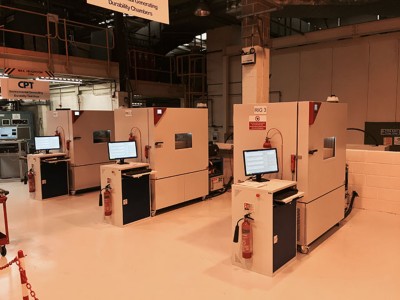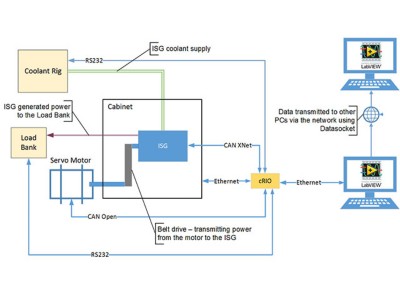Testing Integrated Starter Generators for Hybrid Vehicles
Chris Woodhams, Argenta, Managing Director
"Compared to other systems for this type of testing in the automotive industry, the test cycles are more complex. The rig performs a much wider range of tests than the required test specifications, it simulates rapid changes of gear, speed and vehicle load. A major automotive manufacturer has raised their own specifications for inclusion in the test system."
- Chris Woodhams, Argenta, Managing Director
The Challenge:
We needed to develop and commission a fully automated dynamometer test rig for integrated starter generators (ISGs) used in hybrid vehicles to run accelerated life tests.
The Solution:
We used LabVIEW and NI hardware to create a test rig that can run autonomously by varying temperature, speed, and power. It can also add custom tests throughout the testing procedure.
Author(s):
Paul Bloore - Controlled Power Technologies
Chris Woodhams - Find this author in the NI Developer Community
Dawid Wozny - Argenta
Introduction
Countries across the world are moving toward reducing or banning petrol and diesel cars. The United Kingdom and France have committed to only selling electric or hybrid vehicles by 2040. Car manufacturers are also making a shift with companies such as Volvo committing to only producing electric and hybrid cars in the near future. With this change, it is critical that we meet the test requirements of these vehicles so they can be produced quickly and efficiently.
CPT is a UK-based company that supports product development and validation, prototype manufacture, and customer applications that encompass a diverse range of engineering disciplines. CPT needed to develop and commission a fully automated validation test rig for replacement Integrated Starter Generators (ISGs) used in hybrid vehicles. The company considered using off-the-shelf test rigs; however, due to the complexity of the tests that must be run, these were not yet available. The rig needed to test the performance of the ISGs at different temperatures, speeds, and power generation requirements. It needed to be flexible so the operators could change any aspect of the test procedure to suit the unit under test.
Incotech, a special purpose Automation, Assembly and Testing Machine supplier was selected to provide the mechanical hardware. CPT also needed an integrator due to a lack of internal resources and also required quality assurance and Argenta, a leading provider of test, measurement, control, and automation solutions, and an NI Alliance Partner was recommended. Argenta specialise in the aerospace, automotive, energy, and defence industries with clients ranging from global organisations to small- and medium-sized businesses based throughout the United Kingdom and Europe. CPT and Incotech chose Argenta due to the personal service they provide and their commitment to delivering the expected outcome.
Solution
We set up the test rig so that the drive from a motor could be transferred to the ISG under test through a belt and pulley set. We situated the ISG within an environmental chamber to allow for varying temperatures to be set throughout testing. There is also a load bank that powers the simulation of the ISG in generation mode, acting as a store for the energy generated by the ISG.
The control program enables a separate coolant circuit to ensure the temperature of the ISG is constantly maintained throughout the test.

A test involves a predefined number of cycles and each cycle consists of a predefined chamber temperature and speed profile. Within a profile there are various tests that perform specific actions to simulate scenarios that the ISG would potentially witness. During a test, data is logged from all aspects of the system over the different communication links and stored in files. There are safety systems incorporated into the application to ensure that any issues that arise will initiate a shutdown sequence that informs the relevant people through email.
The CompactRIO manages all signals coming in and out of the system utilising the FPGA and real-time operating system. The CompactRIO platform enables the system to be run headless, without a PC being connected. This eliminates any route for errors caused by a non-deterministic operating system.

The main challenge with this project was ensuring all communication links with the hardware were reliable, responsive, and synchronised. To certify this, we commissioned all systems individually prior to bringing them together to perform the test. This ensured the reliability and responsiveness of each piece of hardware on an individual level, so that when system testing commenced, we could focus only on synchronisation.
We developed a separate application and commissioned it on a PC so the operator can set up test profiles and start and stop tests. It also gives the operator a live update of the current cycle and how many cycles have been completed.
Outcome
The test cycle specifications proved to be complex compared to the existing systems in the automotive industry. The test system we implemented met the required specifications and performed a much wider range of tests. It simulates rapid changes of gear, speeds, and loads in vehicles, so it offers numerous benefits. As a direct outcome, a major automotive manufacturer has now raised its own specifications for inclusion in the test system, which proves that the system can be entirely customisable. Some of these benefits include:
- Cost-effective solution capable of high-performance tests
- Easy to implement and access multiple data sets, which give a better understanding of the unit under test
- Bespoke range of measurements in the automotive industry
- Automated test procedure that can monitor and allow other tasks to be achieved at the same time
Author Information:
Chris Woodhams
Find this author in the NI Developer Community